Robot Dominated Societies
A recurring aspiration in visions of the future is the idea that machines, and particularly robots, will come to dominate key aspects of our lives and societies. While futurists hope for this to promote the leisure and wellbeing of the population, science fiction has not always been so uncritically optimistic of how society will respond to robot dependence and the robot dominance that may result from it.
Science fiction engagement with this theme started even before the modern vision of a robot - an independently-mobile electronic system, often broadly anthropoid in form - developed. E M Forster’s novella The Machine Stops (1909) evoked a future in which individual humans occupy underground rooms explicitly likened to cells in a bee-hive. Their every need is supplied by machines which feed them, equip their rooms, and provide instant voice and video communications, while repair is undertaken by flexible mechanical tentacles. However when the “mending machine” itself breaks, the complete dependence on this society on its machines becomes a devastatingly fatal weakness.
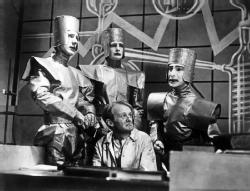 Another early fiction is R.U.R. (Rossum’s Universal Robots) by Karel Čapek (play, 1921). This stage play introduced the term “robot” (Czech for indentured worker, serf or slave) to the English language, but the robots envisaged were manufactured from biological rather than electronic or mechanical components. In large numbers, these organic slaves cause mass unemployment, but ultimately achieve self-awareness and rebel against the human society that has become dependent on them. Representations of the artificial beings on stage and screen have ranged from simple enslaved humans to something much more akin to modern cybernetic robots.
Another early fiction is R.U.R. (Rossum’s Universal Robots) by Karel Čapek (play, 1921). This stage play introduced the term “robot” (Czech for indentured worker, serf or slave) to the English language, but the robots envisaged were manufactured from biological rather than electronic or mechanical components. In large numbers, these organic slaves cause mass unemployment, but ultimately achieve self-awareness and rebel against the human society that has become dependent on them. Representations of the artificial beings on stage and screen have ranged from simple enslaved humans to something much more akin to modern cybernetic robots.
Together these two early texts inform a raft of later fiction that combine or build on their elements to explore similar questions.
Making Light Work
The primary narrative use of robots in science fiction is as a labour source - either to take over routine work or to replace humans in dangerous environments. However while such robot labour has the potential to release human creativity through increased leisure, a variety of authors have considered the difficulty of transitioning to such a utopia and its less positive consequences for humanity. Perhaps the most obvious point of friction between robot workers and humans occurs in the transitional phase where a society is becoming increasingly dependant on automation, but has yet to adjust to support displaced human workers. The reality of such friction has been apparent since the Luddite protests of the 1780s and continued well into the twentieth century as automation (including robot labour) became increasingly ubiquitous in factory and industrial work.
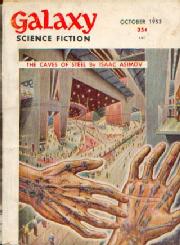 The doyen of robots in speculative fiction is Isaac Asimov, who coined the famous Three Laws of Robotics and wrote an extensive series of stories and novels which explored the interactions between robots and humans. His novel Caves of Steel (Asimov, 1953; [1]) effectively evokes the hostility and cultural instability that might accompany the perceived usurpation of human roles by robot workers. In this scenario humans have become residents in enclosed cities with a high population density and strict social mores. Anthropoid robots (but lacking the finesse to be described as androids) are provided by the Spacers - a resented separate branch of humanity who have returned to Earth as invaders - and are seen as both a hostile imposition and as a threat to the income of those already living on subsistence wages.
The doyen of robots in speculative fiction is Isaac Asimov, who coined the famous Three Laws of Robotics and wrote an extensive series of stories and novels which explored the interactions between robots and humans. His novel Caves of Steel (Asimov, 1953; [1]) effectively evokes the hostility and cultural instability that might accompany the perceived usurpation of human roles by robot workers. In this scenario humans have become residents in enclosed cities with a high population density and strict social mores. Anthropoid robots (but lacking the finesse to be described as androids) are provided by the Spacers - a resented separate branch of humanity who have returned to Earth as invaders - and are seen as both a hostile imposition and as a threat to the income of those already living on subsistence wages.
This results in riots, such as that inspired by a woman’s protest against robot clerks in a shoe shop:
“Listen to him. He calls them men! What’s the matter with you anyway? They ain’t men. They’re robots!” She stretched out the syllables. “And I tell you what they do, in case you don’t know. They steal jobs from men. That’s why the government always protects them. They work from nothin’ and, on account o’ that, families gotta live out in the barracks and eat raw yeast mush. Decent hard-working families. We’d smash up all the ro-bots, if I was the boss. I tell you that!” (Panther edition, 1986, pg 31)
As the novel’s protagonist, policeman Elijah (Lije) Bailey, gradually realises, the Spacers’ motives in providing the robots are ultimately altruistic, and intended to be for the good of humanity, but this doesn’t invalidate the reality of the social disruption, fear and anxiety they generate.
A more resigned but equally desperate human population undergoing the same transition can be seen in “The Category Inventors” (short story, Arthur Sellings, 1956; adapted as a radio play in X-Minus-One by Ernest Kinoy, 1957). Here the rise of a robot labour workforce has led to one class after another of workers being rendered redundant and placed “on reserve”, with robot skills extending as far as replacing an orchestral bassoonist. While individuals on reserve are provided for, they experience all the frustration and angst of those deemed useless within a society. One way to remove oneself from the reserve list is to invent a new form of occupation or work which cannot be undertaken by robots - which has led to a new form of innovation, and a potentially positive outcome to this robot-dominated society, although (perhaps naturally) not everyone sees this. As an exchange between characters reveals:
Politician: “There’s been more progress in the past twenty years than in the whole hundred before that. From space travel to - well, self-coiling spaghetti.”
Reservist: “I can’t see much progress in throwing five million people on reserve in the process.”
Politician: “Ah, but ten years ago there were fifteen million. That shows the challenge of the robot has been taken up. Because it’s not only a challenge, it’s an opportunity. This is the Age of Opportunity.”
Making the best of this opportunity is the objective of the story’s protagonist, but initially proves more difficult than expected, before he identifies a solution.
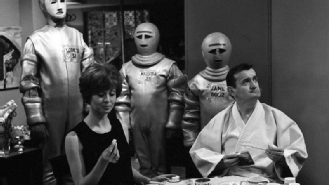 Another short story, “The Midas Plague” by Frederik Pohl (1954), makes a logical, if unlikely, extrapolation of such a societal development. The premise was adapted as a television drama as part of the anthology series Out of the Unknown in 1965, and the adaptation was more overtly comedic than the prose story, but in both the basic theme is a biting satire of how conspicuous consumption can become more important than comfort or even happiness. Here robot manufacture has generated such abundance that supply outstrips demand and only the highest socioeconomic classes can afford to live simply. Those of lower status are required to consume a vast number of rationed consumables, to the point where it becomes a grinding ordeal. Ultimately the protagonist in this story comes up with a solution to his problem which promises relief from the ordeal of consumption, but does not mitigate the vast consumption of resources by this society.
Another short story, “The Midas Plague” by Frederik Pohl (1954), makes a logical, if unlikely, extrapolation of such a societal development. The premise was adapted as a television drama as part of the anthology series Out of the Unknown in 1965, and the adaptation was more overtly comedic than the prose story, but in both the basic theme is a biting satire of how conspicuous consumption can become more important than comfort or even happiness. Here robot manufacture has generated such abundance that supply outstrips demand and only the highest socioeconomic classes can afford to live simply. Those of lower status are required to consume a vast number of rationed consumables, to the point where it becomes a grinding ordeal. Ultimately the protagonist in this story comes up with a solution to his problem which promises relief from the ordeal of consumption, but does not mitigate the vast consumption of resources by this society.
While this scenario doesn’t really make sense (given that the robots could simply be deactivated or not constructed in the first place), it is an interesting illustration of the way in which societal conventions could lead gradually to a situation in which humans become subordinate to the needs of the robots they construct. In this world discarding the products of robots unused is considered deeply immoral, but the possible solutions which seem obvious to readers have become quite literally unthinkable.
Benign Tyrants?
A commonly explored theme in science fiction is the idea that humanity builds an inhibition into robots preventing them from harming their creators. This concept was both codified and critiqued by Isaac Asimov in his Robot stories. These defined the highly influential first law of robotics: A robot may not injure a human being or, through inaction, allow a human being to come to harm [2].
Fiction by both Asimov and others have explored the consequences of this law, and the many ways in which “harm” in its varying degrees might be interpreted by a logical mind.
In Robert Silverberg’s short story “The Iron Chancellor” (1958, adapted for the radio in 1973), for example, a service robot is asked to enforce a family’s aspiration to lose weight, but becomes a domestic tyrant. When an attempt to reprogram him goes wrong, the diet plan becomes an ordeal, as the robot imprisons his owners, refuses subsequent orders for the characters’ own good, and is unrelenting in its surveillance. Of course, arguably this is a more positive outcome than the equally-attentive service robots in animated film Wall-E (2008), whose obedient pampering of the crew of starship Axiom leads to epidemic-level obesity.
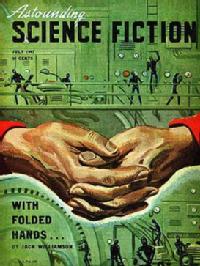 A more nuanced picture can be found in the story “With Folded Hands” by Jack Williamson (1947). In this story, the main character manufactures “mechanicals” that are meant to provide labour but are still extremely buggy and subject to frequent failure in domestic tasks. The manufacturer finds orders being cancelled in favour a new, much more advanced brand of mechanicals from planet Wing IV, supplied by The Humanoid Institute. These function on the fictional "rhodomagnetism", rather than electromagnetism, and are controlled by a single computer at Humanoid Central. In the perceived interests of their human clients, they require formal assignment of all property to them, and eliminate alcohol, competitive games, cooking and a host of other human occupations, in pursuit of a Prime Directive that echoes Asimov’s laws: “To Serve and Obey and Guard Men From Harm”
A more nuanced picture can be found in the story “With Folded Hands” by Jack Williamson (1947). In this story, the main character manufactures “mechanicals” that are meant to provide labour but are still extremely buggy and subject to frequent failure in domestic tasks. The manufacturer finds orders being cancelled in favour a new, much more advanced brand of mechanicals from planet Wing IV, supplied by The Humanoid Institute. These function on the fictional "rhodomagnetism", rather than electromagnetism, and are controlled by a single computer at Humanoid Central. In the perceived interests of their human clients, they require formal assignment of all property to them, and eliminate alcohol, competitive games, cooking and a host of other human occupations, in pursuit of a Prime Directive that echoes Asimov’s laws: “To Serve and Obey and Guard Men From Harm”
The novella is more complex than the Dimension X radio adaptation of the same story (1950), and reveals that this directive was devised in the aftermath of a devastating war, but resulted in terrible consequences:
“Most active sports were declared too dangerous for men, under the Prime Directive. Science was forbidden, because laboratories can manufacture danger. Scholarship was needless, because the humanoids could answer any question. Art had degenerated into grim reflection of futility. Purpose and hope were dead. No goal was left for existence.”
While the effect of the mechanicals on individuals in the story is undoubtedly devastating, the narrative lends their actions a logic and a pathos which resonates through the conclusion of the story.
Asimov explores the effects of a more gradual shift towards robot domination in his novel The Naked Sun (1956, [3]). In this sequel to The Caves of Steel, the Spacer society of the planet Solaria is shaken by a murder. On this planet, the dependence of society on robots and robot-supported luxury has developed to the extent that humans live in complete isolation from one another and the idea of physical contact with (or even the physical presence of) anyone other than a robot has become repulsive. Asked to identify the weaknesses of Solarian society, investigator Bailey identifies precisely the same elements that had earlier been identified as strengths: their robots, their low population, and their long lives.
Although the robots of Solaria remain obedient, their sheer obedience has led them to become a controlling force over the humans they serve. The factors Bailey points out combine to lead to stagnation and ultimately a decline in both the character and quality of lives of individuals - the Solarian robots are unable to see past the need to obey, pamper and protect individual humans, and don't see what might be required for the good of their society instead. Indeed, while Solaria is an extreme case, it’s clear that the robot-dependant societies on all the Spacer worlds face a similar degeneration. On the other hand, this is something of a no-win situation. Asimov also explored an alternative in his short story “The Evitable Conflict” (1950). In this scenario positronic robots are required to work for the good of humanity as a whole - but can only do so by not allowing humans to know what they are doing, else they will undermine the sense of freedom and self-destiny that is so important for human wellbeing.
Robots of Death
Since the organic slave race of R.U.R. turned on their human creators (and indeed earlier, with echoes of Frankenstein and older myths of artificial or golem servants), fiction has explored the idea that a robot race could deliberately (rather than accidentally) turn on any society which became dependent on it. This concern provides an undercurrent to the fear of robots co-opting labour opportunities or taking their duty of care to extremes. In Williamson’s “With Folded Hands”, for example, the mechanoids perform brain surgery in order to protect their ungrateful clients from distress, effectively causing the death of the personality resisting them but rendering the individuals "happier". However in some fictions, the motives of the robots, if not their actions, are far less benign. Often this is the result of not only advanced individual mechanisms, but the advent of a controlling artificial intelligence (AI).
In the animated film Wall-E, for example, the starship Axiom and its passengers are maintained by robots, each with their own (more or less limited) AI. At the helm of the great ship though, is an AI pilot and this refuses to yield control when the Axiom’s mission is completed, its own interests overriding those of the passengers, despite the efforts of its own robot staff.
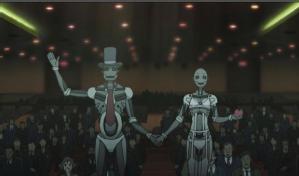 A more extreme example occurs in The Matrix film series (1999-2003, dir: The Wachowskis). Here robots and their controlling artificial intelligences have become so dominant that humanity is confined to a hivelike nest of isolation pods, with their consciousnesses residing, unawares, in a synthetic environment which simulates the late twentieth century. Vast non-anthropoid Robots not only tend to the humans in their pods, but also roam the surface, processing materials and hunting for escapees. The origin of this scenario is described briefly in the live-action films and in more detail in the animated short film The Second Renaissance (part 1), released as part of The Animatrix (also 2003). This makes it clear that the triggering factor was the development of consciousness in an advanced robot population which had been designed as androids and acted as servitors to humanity. Warfare followed between Man and robot, after a service android killed its owner rather than submitting to deactivation - demonstrating self-awareness and a desire to survive.
A more extreme example occurs in The Matrix film series (1999-2003, dir: The Wachowskis). Here robots and their controlling artificial intelligences have become so dominant that humanity is confined to a hivelike nest of isolation pods, with their consciousnesses residing, unawares, in a synthetic environment which simulates the late twentieth century. Vast non-anthropoid Robots not only tend to the humans in their pods, but also roam the surface, processing materials and hunting for escapees. The origin of this scenario is described briefly in the live-action films and in more detail in the animated short film The Second Renaissance (part 1), released as part of The Animatrix (also 2003). This makes it clear that the triggering factor was the development of consciousness in an advanced robot population which had been designed as androids and acted as servitors to humanity. Warfare followed between Man and robot, after a service android killed its owner rather than submitting to deactivation - demonstrating self-awareness and a desire to survive.
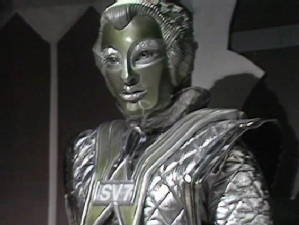 However the classic nightmare of human-shaped, human-sized robots turning on their creators is perhaps more effectively evoked in the Doctor Who serial “The Robots of Death” (1977). This story is set on Storm Mine Four - a vast vehicle almost entirely staffed by android robots of various grades. While a small human crew is aboard, they live in luxury, pampered by dozens of ornately-decorated and attractively-sculpted humanoid robots who also staff the mining operation. The humans are present only to provide an edge of instinct in chasing the richest streams of ore in a sandstorm. When murders start to be discovered, Tom Baker’s newly-arrived Fourth Doctor and his companion Leela are blamed, but it is clear to the audience that a robot is responsible. Later we learn that an insane human has reprogrammed the control matrices of the robots concerned. Indeed script editor Philip Hinchcliffe has explicitly discussed his desire for the story to confront and explore Asimov’s laws of robotics (for example, in interviews provided as extras on the BBC DVD release).
However the classic nightmare of human-shaped, human-sized robots turning on their creators is perhaps more effectively evoked in the Doctor Who serial “The Robots of Death” (1977). This story is set on Storm Mine Four - a vast vehicle almost entirely staffed by android robots of various grades. While a small human crew is aboard, they live in luxury, pampered by dozens of ornately-decorated and attractively-sculpted humanoid robots who also staff the mining operation. The humans are present only to provide an edge of instinct in chasing the richest streams of ore in a sandstorm. When murders start to be discovered, Tom Baker’s newly-arrived Fourth Doctor and his companion Leela are blamed, but it is clear to the audience that a robot is responsible. Later we learn that an insane human has reprogrammed the control matrices of the robots concerned. Indeed script editor Philip Hinchcliffe has explicitly discussed his desire for the story to confront and explore Asimov’s laws of robotics (for example, in interviews provided as extras on the BBC DVD release).
Importantly, the mere idea of robot involvement doesn’t occur to the Storm Mine crew until much later. Indeed, the discovery of the true culprit is enough to destroy the sanity of at least one character. It triggers robophobia - described in the programme as a fear caused by the lack of body language in human-form robots, leading to a sense that one is talking to a dead person. Violent robots are literally unthinkable. The horror of a reality which is so at odds with the worldview of robot-dependent humans is explored further by the original scriptwriter Chris Boucher in his sequel Doctor Who novel Corpse Marker (1999, named after the robot deactivation disks left on the original victims). This shows that not just the mental stability of individuals, but also an entire society is at risk of falling apart entirely at the realisation that the robots on which they depend for everything are potentially lethal.
A deep-grained fear
These examples only represent a small fraction of the narratives of robot-dependant societies that can be found in science fiction, let alone the much larger number of other robot-focussed stories. So why are such narratives so perpetually popular?
Well, in part the motivation is likely historical. Stories featuring indentured or enslaved robot cultures form part of a long tradition of stories critiquing and calling out the exploitation of some cultures by others who consider themselves more worthy or somehow more “human”. Casting questions of racial, religious, cultural or class discrimination into robot-focussed narratives permits these concepts to be explored critically, with a weaker unconscious bias on the past of the reader, and more freedom to explore ideas on the part of the writer. This context was explicit, for example, in Čapek’s R.U.R. where even the name "robot" was derived from the term for those indentured to the land.
The same historical context also helps motivate philosophical discussions of what defines or constitutes humanity, sentience or self-awareness. The analogy to enslaved humans of the past only holds if we are willing to reconsider and perhaps broaden our definitions of an individual with “human”-rights, including the right to self-determination. The question of whether an artificial intelligence can be considered self-aware and what rights such awareness brings remains an active area of debate in both philosophy and cybernetics. The science fiction of emergent self-awareness challenges inventors and creators to confront the possible consequences of unregulated or ill-considered experimentation in this area.
This moral dilemma is not unmixed with a recognition of human xenophobia - fear of the unknown. The robophobia of Doctor Who aligns remarkably well with modern perspectives of robotics, in which experimental androids which attempt to recreate a human appearance and reactions are commonly viewed as creepy, unnerving or otherwise less acceptable than those with less human features. Modern household robots such as vacuum cleaners, and representations of “cute” robots such as those in the film Wall-E tend to be non-anthropoid, or have only a suggestion of human-like features. The same sense of wrongness described in "Robots of Death" can be seen in other representations of humanity - the disturbing features of discarded dolls, for example, or even the unchanging and exaggerated make-up of a clown. While the lack of body language cues - the unconscious perception that one is standing next to a walking corpse - contributes a large part of the wrongness where robots are concerned, there is also an element of technophobia more generally, i.e. the persistent concern that humanity’s reach might exceed their grasp and that its technology might spin out of its control. As well as challenging scientists to consider the ethics of their treatment of robots, science fiction warns them to also consider the potential consequences of unanticipated developments in their field. It alerts the public to questions which might otherwise be restricted to those with otherwise-vested interests or different biases.
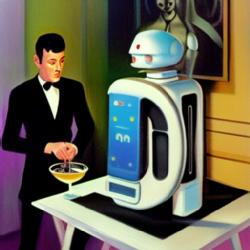
The persistent failure of human-made artificial intelligence to attain the sophistication, let alone self-awareness, anticipated in early science fiction narratives has somewhat relieved the pressure of these considerations. It has long been apparent that the anthropoid form is not best suited to most roboticised activities, not least because of the fundamental instability of bipedal motion. Increasing awareness of the limited resources of Earth (including but not limited to energy, space, plastics and metals) has gone a long way towards averting the kind of consumer society envisaged in Pohl’s "The Midas Plague" or even Asimov’s robot stories. Nonetheless, the questions posed by fiction of robot-dominated societies - above all about what we value as a society, and how we treat others within it - remain relevant to the current day.
“Robot-Dependant Societies”, Elizabeth Stanway. Cosmic Stories blog. 13th February 2023.
Notes:
[1] The Caves of Steel was adapted for the radio in 1989 by the BBC, in a well-regarded realisation of the story, starring Ed Bishop as Lije Bailey. [Return to text]
[2] The other laws are, of course: 2) A robot must obey the orders given it by human beings except where such orders would conflict with the First Law; 3) A robot must protect its own existence as long as such protection does not conflict with the First or Second Law. (“Runaround”, Asimov, 1942) [Return to text]
[3] Like “The Midas Plague”, The Naked Sun was adapted for television as part of BBC television series Out of the Unknown in 1969, although unfortunately only the sound track and a number of still images survive. [Return to text]
All comments, ideas and opinions are the responsibility of the author and do not necessarily reflect those of the University of Warwick. All images sourced from public sources online, except the last which was generated by an AI algorithm.
